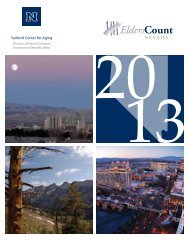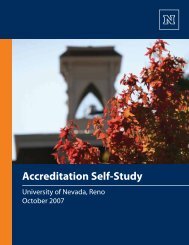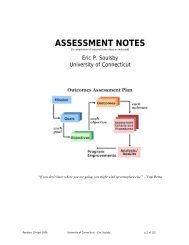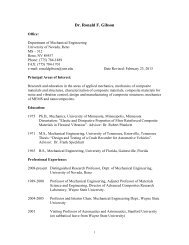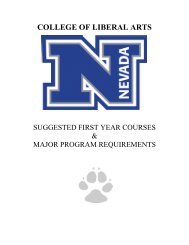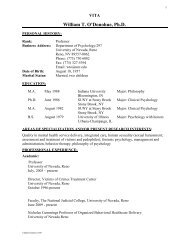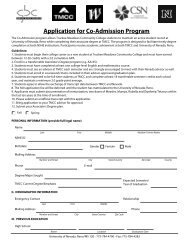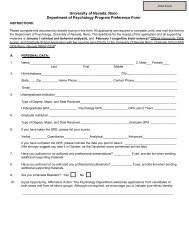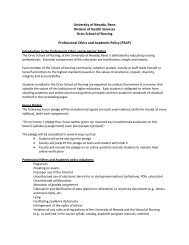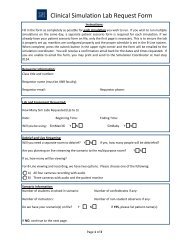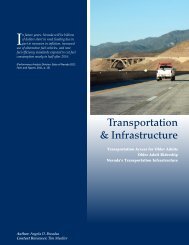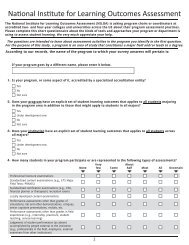Download full issue - University of Nevada, Reno
Download full issue - University of Nevada, Reno
Download full issue - University of Nevada, Reno
You also want an ePaper? Increase the reach of your titles
YUMPU automatically turns print PDFs into web optimized ePapers that Google loves.
School <strong>of</strong> Medicine pr<strong>of</strong>essor <strong>of</strong><br />
physiology and cell biology Carl<br />
Sievert speaks to medical students<br />
in the new anatomy lab.<br />
New anatomy lab takes <strong>Nevada</strong> medical education to the next level<br />
Physiology and cell biology pr<strong>of</strong>essor Carl Sievert is excited.<br />
As the anatomy course director at the School <strong>of</strong> Medicine, Sievert is<br />
anxious to begin teaching medical students in the new, larger anatomy<br />
laboratory in the William N. Pennington Health Sciences Building.<br />
“I love what I’m doing here at the School <strong>of</strong> Medicine with its focus on the<br />
development and progression <strong>of</strong> medical students,” he says.<br />
Students learn anatomy by studying and dissecting human cadavers<br />
obtained through the anatomical donation program. Cadavers are presented<br />
on tables, or stations, with several students gathered around each table<br />
observing procedures demonstrated on computer screens before doing the<br />
procedure themselves.<br />
The new lab will bring the number <strong>of</strong> stations to 28 from just 15 previously,<br />
and each station can handle four or five students. “The extra capacity allows<br />
the medical school to gradually build up to the new class size,” Sievert notes.<br />
“Each station has a directional speaker system so students can stand at their<br />
own table watching a monitor with the sound directly overhead, flowing over<br />
the table without noise migrating to other tables.”<br />
In addition to standard room lighting, each dissecting table has its own<br />
high-intensity Led directional lighting system for greater visibility during<br />
dissection.<br />
Large computer screens allow for better imaging at each station.<br />
Additional computer monitors, some up to 52 inches, and a high-resolution<br />
camera system mounted over a central demonstration table at each station<br />
will record and project dissection techniques and surgical procedures.<br />
Another new technology in the anatomy lab is the virtual human dissector<br />
computer program, which <strong>of</strong>fers rotational 3-D imaging <strong>of</strong> the human body<br />
in layers at each station.<br />
The cadaver-handling system in the Pennington Health Sciences Building<br />
is also improved and allows for on-site embalming by a mortician with skill<br />
in anatomical dissection embalming techniques for long-term preservation<br />
<strong>of</strong> cadavers. This capability allows the School <strong>of</strong> Medicine to provide<br />
opportunities for community physicians and medical supply company<br />
representatives to train in new surgical procedures, a popular trend at<br />
medical schools across the country, according to Sievert.<br />
The new anatomy lab is so state-<strong>of</strong>-the-art that second-year medical<br />
students who have toured the lab have joked about repeating the first-year<br />
anatomy course to take advantage <strong>of</strong> the improved facilities, Sievert says.<br />
“We have a supplemental instruction program in which second-year<br />
students help first-year students with exam preparation. This building has<br />
spiked interest in that program because second-year students, who have<br />
already completed the anatomy course in their first year, want to come back<br />
and learn at this new facility.”<br />
Second-year students will also benefit from the new facility by refreshing<br />
their anatomy knowledge before heading to their third-year clerkships. And<br />
fourth-year students with an interest in surgery subspecialties can use the<br />
new anatomy lab to improve their skills before graduating and heading <strong>of</strong>f to<br />
their residencies.<br />
Space has also been set aside in the lab for a museum room where<br />
donated anatomical material will be on permanent display.<br />
—Anne McMillin, APR<br />
<strong>Nevada</strong> Silver & Blue • Summer 2011<br />
5



